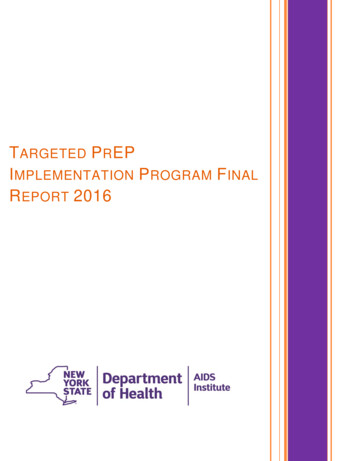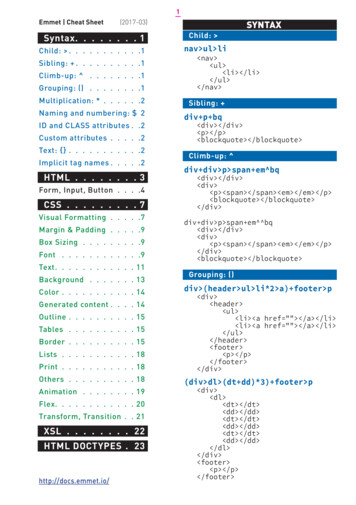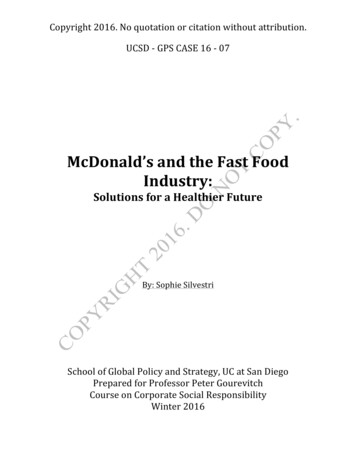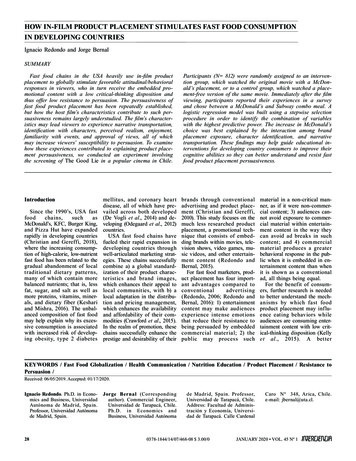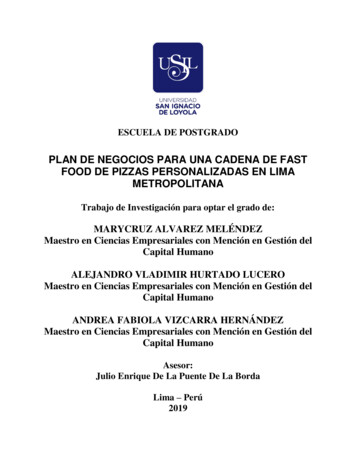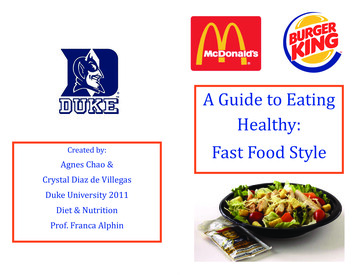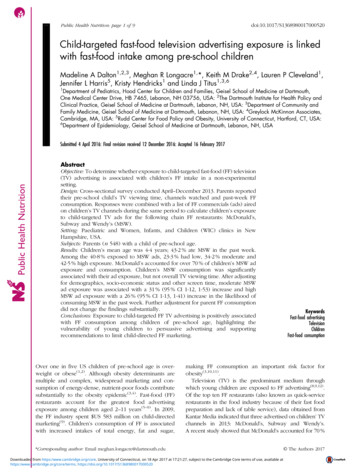
Transcription
doi:10.1017/S1368980017000520Public Health Nutrition: page 1 of 9Child-targeted fast-food television advertising exposure is linkedwith fast-food intake among pre-school childrenMadeline A Dalton1,2,3, Meghan R Longacre1,*, Keith M Drake2,4, Lauren P Cleveland1,Jennifer L Harris5, Kristy Hendricks1 and Linda J Titus1,3,61Department of Pediatrics, Hood Center for Children and Families, Geisel School of Medicine at Dartmouth,One Medical Center Drive, HB 7465, Lebanon, NH 03756, USA: 2The Dartmouth Institute for Health Policy andClinical Practice, Geisel School of Medicine at Dartmouth, Lebanon, NH, USA: 3Department of Community andFamily Medicine, Geisel School of Medicine at Dartmouth, Lebanon, NH, USA: 4Greylock McKinnon Associates,Cambridge, MA, USA: 5Rudd Center for Food Policy and Obesity, University of Connecticut, Hartford, CT, USA:6Department of Epidemiology, Geisel School of Medicine at Dartmouth, Lebanon, NH, USAPublic Health NutritionSubmitted 4 April 2016: Final revision received 12 December 2016: Accepted 16 February 2017AbstractObjective: To determine whether exposure to child-targeted fast-food (FF) television(TV) advertising is associated with children’s FF intake in a non-experimentalsetting.Design: Cross-sectional survey conducted April–December 2013. Parents reportedtheir pre-school child’s TV viewing time, channels watched and past-week FFconsumption. Responses were combined with a list of FF commercials (ads) airedon children’s TV channels during the same period to calculate children’s exposureto child-targeted TV ads for the following chain FF restaurants: McDonald’s,Subway and Wendy’s (MSW).Setting: Paediatric and Women, Infants, and Children (WIC) clinics in NewHampshire, USA.Subjects: Parents (n 548) with a child of pre-school age.Results: Children’s mean age was 4·4 years; 43·2 % ate MSW in the past week.Among the 40·8 % exposed to MSW ads, 23·3 % had low, 34·2 % moderate and42·5 % high exposure. McDonald’s accounted for over 70 % of children’s MSW adexposure and consumption. Children’s MSW consumption was significantlyassociated with their ad exposure, but not overall TV viewing time. After adjustingfor demographics, socio-economic status and other screen time, moderate MSWad exposure was associated with a 31 % (95 % CI 1·12, 1·53) increase and highMSW ad exposure with a 26 % (95 % CI 1·13, 1·41) increase in the likelihood ofconsuming MSW in the past week. Further adjustment for parent FF consumptiondid not change the findings substantially.Conclusions: Exposure to child-targeted FF TV advertising is positively associatedwith FF consumption among children of pre-school age, highlighting thevulnerability of young children to persuasive advertising and supportingrecommendations to limit child-directed FF marketing.Over one in five US children of pre-school age is overweight or obese(1,2). Although obesity determinants aremultiple and complex, widespread marketing and consumption of energy-dense, nutrient-poor foods contributesubstantially to the obesity epidemic(3,4). Fast-food (FF)restaurants account for the greatest food advertisingexposure among children aged 2–11 years(5–9). In 2009,the FF industry spent US 583 million on child-directedmarketing(9). Children’s consumption of FF is associatedwith increased intakes of total energy, fat and sugar,KeywordsFast-food advertisingTelevisionChildrenFast-food consumptionmaking FF consumption an important risk factor forobesity(3,10,11).Television (TV) is the predominant medium throughwhich young children are exposed to FF advertising(8,9,12).Of the top ten FF restaurants (also known as quick-servicerestaurants in the food industry because of their fast foodpreparation and lack of table service), data obtained fromKantar Media indicated that three advertised on children’ TVchannels in 2013: McDonald’s, Subway and Wendy’s.A recent study showed that McDonald’s accounted for 70 %*Corresponding author: Email meghan.longacre@dartmouth.eduDownloaded from https:/www.cambridge.org/core. University of Connecticut, on 18 Apr 2017 at 17:21:27, subject to the Cambridge Core terms of use, available athttps:/www.cambridge.org/core/terms. https://doi.org/10.1017/S1368980017000520 The Authors 2017
Public Health Nutrition2of televised FF commercials (ads) aimed at young children,far exceeding Subway and Wendy’s advertising(13).McDonald’s also surpasses Subway and Wendy’s in terms ofsales. In 2013, McDonald’s US sales revenue topped US 35billion, compared with approximately US 12·7 billion forSubway and US 8·6 billion for Wendy’s(14).Young children do not have the cognitive ability tounderstand or recognize the persuasive intent of advertisingand thus may be highly susceptible to food industrymarketing tactics(15–19). Experimental studies demonstratethat food marketing directly influences young children’s foodand taste preferences(20–24), their requests to purchaseadvertised foods(25) and their short-term consumption ofadvertised foods(26–29). Many studies have demonstrated anassociation between TV viewing and adiposity or lesshealthy dietary choices among children(28,30–34). In thesestudies, TV viewing time is often used as a proxy measurefor exposure to food advertising, presumably because of thedifficulty of assessing children’s exposure to TV advertisingoutside a laboratory setting(35). However, this type ofapproach makes it difficult to isolate the effects of foodadvertising from other risk factors associated with TV viewing, such as snacking. In a longitudinal study, Zimmermanand Bell found that commercial TV viewing by childrenunder 6 years of age predicted higher BMI, whereasnon-commercial TV viewing did not(36). Additionally, a studyof 4- to 12-year-old children in the Netherlands found TVadvertising exposure was positively associated with consumption of advertised food brands among low-incomechildren(37). Despite extensive research documenting thecontent of TV food advertising in the USA(7,9,38–40) and highlevels of concern about children’s exposure to this advertising, there is a surprising lack of empirical data examiningthe impact of food advertising on children’s dietary intake innon-experimental, real-world settings(41).In the present analysis, we used data from a larger studyof electronic media use and diet in children of pre-schoolage to determine whether exposure to child-targeted FF TVadvertising is associated with young children’s FF intake.MethodsStudy designBetween April 2013 and March 2014, trained researchassistants were stationed in the waiting rooms of paediatricoutpatient and Women, Infants, and Children (WIC) clinicslocated in Manchester and Nashua, New Hampshire, USA.Research assistants recruited participants by inviting parentsto complete a survey about ‘children’s media use and foodchoices’. Surveys were pre-tested with a demographicallycomparable sample for comprehension, face validity andcompletion time. Eligibility for study participation includedchildren’s age (3–5 years) and parents’ ability to complete awritten survey in English or Spanish. If parents had multipleage-eligible children, we selected the child present for anMA Dalton et al.appointment. Computer-generated random number listswere used to randomly recruit one child when multipleage-eligible siblings were present for an appointment. Parents received a US 10 gift card and children received a toyfor participating.Of the 1349 parents approached, 516 were not eligible,241 declined and 592 enrolled. The primary reason for notparticipating was insufficient time (44 % of refusals). For thepresent analysis, we included data from 548 parents whocompleted the 136-item survey between April and December2013, which corresponded to our advertising data timeperiod. The analysis focused on three FF restaurants –McDonald’s, Subway and Wendy’s (MSW) – that met thefollowing criteria: ranked in the top ten quick-servicerestaurants based on annual sales(14); at least one outletlocated in each recruitment area; and advertised onchildren’s TV channels during the last three quarters of 2013.MeasuresFast-food consumptionConsistent with measures used in prior population-basedstudies(42–44), we asked parents: ‘In the past 7 days, did yourchild have something to eat or drink from (McDonald’s;Subway; Wendy’s)?’ (responses: yes/no/don’t know foreach). For MSW consumption, responses were combinedinto a dichotomous outcome indicating whether a child hadeaten at any of the three FF restaurants during the past 7 d.We also examined children’s consumption of McDonald’sfood and beverages separately, using parent responsesto this question, because of its prominence in sales andchild-targeted advertising.Fast-food television advertising exposureChildren’s exposure to child-targeted MSW TV ads wasbased on parental report of children’s viewing time andchannels watched. First, we asked: ‘On average, how manydays a week does your child do the following activities:watch TV (regular, cable or satellite)? (0, 1–2, 3–4, 5–6,7 days)’. We then asked: ‘On days when your child does thefollowing activities, about how much time does your childspend: watching TV (regular, cable or satellite)? (0 to6 hours with 30 minute segments)’. For channels, weasked: ‘In the past 7 d, has your child watched any of thefollowing TV channels? (Boomerang; Cartoon Network; TheDisney Channel; Disney Junior; Disney XD; The Hub (nowcalled Discovery Family); Nickelodeon; Nick Jr.; Nicktoons;PBS Kids; Sprout)’. For each child, we calculated weekly TVviewing time by multiplying the number of days per weekby the number of hours per day the child watched TV. Wethen estimated each child’s weekly exposure to specific TVchannels by dividing weekly viewing time by the numberof children’s channels the child watched in the past 7 d. Thisexposure measure was based on previously validatedmeasures developed to examine children’s exposure totobacco use in electronic media(45–47).Downloaded from https:/www.cambridge.org/core. University of Connecticut, on 18 Apr 2017 at 17:21:27, subject to the Cambridge Core terms of use, available athttps:/www.cambridge.org/core/terms. https://doi.org/10.1017/S1368980017000520
Fast-food ad exposure and children’s fast-food intakeCovariatesIn the parent survey, we assessed demographics (childgender, race and age) and socio-economic status (parenteducation and household income). We assessed children’sother screen time (DVD/videos, streaming, apps, Internetuse and electronic games) using the TV viewing questionformat. To assess parent FF intake we asked: ‘How oftendo you have something to eat or drink from a fast foodrestaurant? (never to 5 or more times a week)’.Statistical analysisWe tabulated MSW/McDonald’s ad exposure and covariatesand compared the likelihood of MSW/McDonald’sconsumption among different subgroups using χ2 tests. Weused Poisson regression with robust variance estimates toestimate the risk ratios of eating at MSW or McDonald’s in thepast 7 d for each level of MSW/McDonald’s ad exposure(48,49).The fully adjusted models included all measured covariates.To maximize the sample size, we used multiple imputationby chained equations(50) to impute values for all variablesin the multivariate models with missing data (0·2–5·8 %per variable). All analyses were conducted in the statisticalsoftware package Stata version 12.ResultsSample characteristicsChildren’s mean age was 4·4 (SD 0·8) years and 51·6 %were female. Seventy-two per cent were non-Hispanicwhite; the majority (59·4 %) of the others were Latino. Most(86·7 %) participating parents were mothers. Approximately half (52·7 %) the parents reported an annualhousehold income of US 50 000 or less; 48·5 % reported‘high school or less’ as their highest level of education.The study sample was slightly more diverse and had alower household income than the underlying populationsof our recruitment cities (in Manchester and Nashua,respectively: 82 % and 79 % non-Hispanic white; medianhousehold incomes of US 54 320 and US 65 671).Fast-food advertisingOverall, 17 311 MSW ads were identified for the currentanalysis. Only five of the eleven children’s channels airedMSW ads during the study period (Fig. 1). Almost one-third(31·7 %) of all MSW ads were aired on Nicktoons. Sixty-nineper cent of the ads were for McDonald’s, 21·7 % for Wendy’sand 9·1 % for Subway. Almost two-thirds of all McDonald’sads were aired on Nickelodeon and Nicktoons.Children’s television viewingChildren’s overall screen time averaged 21·5 (SD 19·9)h/week. TV viewing (regular, cable or satellite) represented nearly half (47·7 %) of their overall screen time andaveraged 9·3 (SD 8·3) h/week. Eighty-nine per cent ofchildren watched at least one children’s TV channel duringthe week before the survey and these children vieweda mean of 3·6 (SD 2·0) children’s channels. Children’schannels aired between 0 and 1·2 MSW ads/h (Table 1).Fast-food advertising exposureMore than half of the children watched only children’schannels without MSW advertising. Based on children’s TVviewing during the past 7 d, 59·2 % were not exposed any tochild-targeted MSW ads whereas 40·8 % were exposed to atleast one. Among the exposed, 23·3 % had low exposure(mean 0·57 (SD 0·26) ads), 34·2 % moderate (mean 1·92(SD 0·58) ads) and 42·5 % had high exposure (mean 6·71(SD 3·83) ads). Among those exposed to McDonald’s ads,33·8 % had low exposure (mean 0·54 (SD 0·29) ads), 34·2 %moderate (mean 1·84 (SD 0·60) ads) and 32·0 % had high(mean 5·36 (SD 2·59) ads). On average, McDonald’s adsaccounted for 73·6 (SD 23·5) % of children’s overall exposure;Wendy’s accounted for 17·4 (SD 20·7) %; and Subway3530% of MSW adsPublic Health NutritionLists of child-targeted FF advertising by channel forApril–December 2013 were obtained from Kantar MediaTM,a company that tracks TV ads on an hourly basis. For eachday, we calculated channel-specific averages of the numberof MSW or McDonald’s ads aired per hour between 06.00and 23.00 hours or during child programming. For example,we did not include ads aired during Nick-at-Nite, whichbegins as early as 20.00 hours and shares channel space withNickelodeon, because its programming is aimed at olderaudiences. We then multiplied each child’s channel-specificweekly exposure time by the average number of MSW orMcDonald’s ads aired per hour on that channel during the7 d prior to each survey. The resulting advertising exposurescores approximate the mean number of child-targeted MSWor McDonald’s ads each child was exposed to during theweek prior to the survey. Based on the distribution ofthe data, we categorized the scores to provide roughlycomparable groups in terms of sample size as follows:none (0), low ( 1), moderate (1–3) and high ( 3).32520151050Nicktoons Cartoon Network NickelodeonThe Hub*Disney XDChildren’s TV channelFig. 1 Percentage of McDonald’s ( ), Subway ( ) andWendy’s ( ) commercials (ads) out of the total number ofMcDonald’s, Subway and Wendy’s (MSW) ads aired on children’stelevision (TV) channels between 06.00 and 23.00 hours orduring child programming, USA, April–December 2013.*Currently known as Discovery FamilyDownloaded from https:/www.cambridge.org/core. University of Connecticut, on 18 Apr 2017 at 17:21:27, subject to the Cambridge Core terms of use, available athttps:/www.cambridge.org/core/terms. https://doi.org/10.1017/S1368980017000520
4MA Dalton et al.Table 1 Percentage of pre-school children who watched children’s television (TV) channels and mean number ofMcDonald’s, Subway and Wendy’s (MSW) commercials (ads) aired per hour by channel during the 7 d precedingeach survey, Manchester and Nashua, NH, USA, April–December 2013MSW ads/h*Children’s TV channelDisney JuniorPBS KidsNick Jr.The Disney ChannelSproutNickelodeonCartoon NetworkThe Hub†Disney XDNicktoonsBoomerangViewed in past 7 d (n 548, �30·5McDonald’s ·30·4Public Health Nutrition*Only ads aired between 06.00 and 23.00 hours or during child programming (for Nickelodeon and Cartoon Network)were included.†Currently known as Discovery Family.accounted for 9·0 (SD 14·6) %. Children’s MSW adexposure was positively associated with the followingchild characteristics: male gender (P 0·03), non-white race(P 0·001), hours of TV viewing (P 0·001) and hours ofother screen time (P 0·02); inversely associated withhousehold income (P 0·002) and parent education(P 0·001); and not significantly associated with child age andparent FF consumption. Children’s McDonald’s ad exposureshowed similar associations and also was positively associatedwith child age (P 0·02).Children’s fast-food consumptionForty-three per cent (n 228) of children ate at MSW in the pastweek: 34·4 % ate at McDonald’s, 9·9 % at Wendy’s and 5·1 %at Subway. Most (88·2 %) children ate at only one of theserestaurants. Children’s MSW consumption was significantlyassociated with their MSW ad exposure (Table 2). Theassociation between McDonald’s consumption and adexposure was marginally significant. Children’s MSW andMcDonald’s consumption were positively associated withparent FF consumption, but not significantly associated withoverall hours of TV viewing, hours of other screen time orother sociodemographic characteristics.Associations between children’s fast-foodconsumption and exposure to advertisingAfter adjusting for demographics, socio-economic statusand other screen time, children with moderate MSW adexposure were 31 % (95 % CI 1·12, 1·53) more likely to haveeaten at MSW in the past week compared with childrenwith no MSW ad exposure (Table 3). Children with highMSW exposure were 26 % (95 % CI 1·13, 1·41) more likelyto have eaten at MSW in the past week compared withchildren with no MSW ad exposure. Children with moderate and high levels of McDonald’s ad exposure were 38 %(95 % CI 1·17, 1·62 and 95 % CI 1·09, 1·76, respectively)more likely to have eaten at McDonald’s in the past weekcompared with children with no exposure. Low MSW orMcDonald’s ad exposure was not significantly associatedwith increases in consumption. In the adjusted models,none of the covariates were significantly associated withchildren’s MSW or McDonald’s consumption. Althoughparent FF consumption significantly predicted children’sMSW and McDonald’s consumption, adding it to theadjusted models did not change the findings substantially.DiscussionThe present study is the first to demonstrate a significantpositive association between exposure to child-targeted FFTV advertising and FF consumption among children ofpre-school age in a non-experimental setting. To somedegree, this association is expected, especially consideringFF industry expenditures on child-targeted advertising.However, demonstrating it empirically is challenging due tothe broad nature of the exposure. Children’s MSW andMcDonald’s consumption were significantly associated withtheir ad exposure, but not overall hours of TV viewing orother screen time. This supports the specificity of ourmeasure and suggests our findings do not merely reflectdifferences among children who watch a lot of TV. Ourresults extend the findings of previous studies that haveidentified TV viewing as a risk factor for adiposity orunhealthy dietary choices(28,30,32–34,36,51) by identifyingadvertising as a possible mechanism for this association. Italso demonstrates that food marketing influences observedin highly controlled, experimental settings with children(29)are consistent with associations observed in uncontrolled,non-experimental settings with greater external validity, andthat this is the case even for pre-school children. Empiricalevidence of the association between children’s exposure tofood marketing and their intake of advertised products, suchDownloaded from https:/www.cambridge.org/core. University of Connecticut, on 18 Apr 2017 at 17:21:27, subject to the Cambridge Core terms of use, available athttps:/www.cambridge.org/core/terms. https://doi.org/10.1017/S1368980017000520
Fast-food ad exposure and children’s fast-food intake5Table 2 Pre-school children’s consumption of McDonald’s, Subway, and Wendy’s (MSW) in the past 7 dby child and parent characteristics, Manchester and Nashua, NH, USA, April–December 2013Public Health NutritionnChild advertising exposuresMSW ad exposureNone318Low51Moderate75High93McDonald’s ad exposureNone318Low74Moderate75High70Child characteristicsGenderFemale283Male265Age3 years1934 years2085 years146RaceNon-Hispanic white380Other144Television watching (h/week) 1551·1–51265·1–1013010·1–14139 1483Other screen time (h/week) 1411·1–51645·1–101335610·1–14 14133Parent characteristicsAnnual household income ( US) 25 00015025 001–50 00012250 001–100 000156 100 00088Parent educationHigh school or less257Associates or technical111degreeBachelor’s or graduate162degreeParent fast-food consumptionNever51Less than once per month 170Less than once per week147Once per week or more167Total548MSW in past 7 d(%)P valueMcDonald’s in past 7 d(%)P 00·5740·416·732·744·461·343·2as that noted in the present study, is critical to supporting andstrengthening the recommendations of numerous publichealth authorities to limit marketing of low-nutrient foods tochildren(3,4,28,52).Much of the prior literature examining food marketing tochildren has focused on school-age children(29,35). Theresults of the current study further illustrate that the influenceof food marketing may begin as young as 3 years of age.Many have raised substantial concern about marketing thattargets young children due to their cognitive inability to31·6 0·00110·423·238·049·734·4 0·001discern the persuasive intent of marketing(16–18). However,major food companies claim that their advertising is notintended for children under 6 years of age as they do notadvertise on TV channels directed primarily to pre-schoolers(i.e. Nick Jr., Disney Junior)(53). Although the pre-schoolchannels offer commercial-free programming choices foryoung children, these are not the only children’s channelschildren are watching. Our results suggest that a substantialminority (40·8 %) of 3–5-year-olds are nevertheless beingexposed to child-targeted ads via TV channels widely viewedDownloaded from https:/www.cambridge.org/core. University of Connecticut, on 18 Apr 2017 at 17:21:27, subject to the Cambridge Core terms of use, available athttps:/www.cambridge.org/core/terms. https://doi.org/10.1017/S1368980017000520
6MA Dalton et al.Table 3 Risk ratios (RR) for pre-school children’s consumption of McDonald’s, Subway or Wendy’s (MSW) in past 7 d, Manchester andNashua, NH, USA, April–December 2013Unadjusted RR95 % CIAdjusted* RRMSW consumption by level of child-targeted MSW commercial (ad) exposureMSW ad exposureNoneRef.Ref.Low1·280·89, 1·841·25Moderate1·341·15, 1·571·31High1·311·21, 1·431·26McDonald’s consumption by level of child-targeted McDonald’s ad exposureMcDonald’s ad exposureNoneRef.Ref.1·16Low1·160·84, 1·60Moderate1·401·18, 1·671·38High1·431·16, 1·761·3895 % CIAdjusted† RR0·89, 1·781·12, 1·531·13, 1·411·191·251·190·84, 1·601·17, 1·621·09, 1·761·091·281·3395 % CIRef.0·83, 1·701·15, 1·361·07, 1·32Ref.0·79, 1·501·05, 1·561·06, 1·67Public Health NutritionRef., reference category.Significant results are indicated in bold font.*Adjusted for child gender, age, race, other screen time, household income and parent education.†Adjusted for child gender, age, race, other screen time, household income and parent education plus parent fast-food consumption.by both younger and older children (e.g. Nickelodeon,Cartoon Network) and that this exposure is associated withtheir intake of the advertised foods.In the USA, child-directed food marketing is self-regulatedby a voluntary body of the Council of Better BusinessBureaus, called the Children’s Food and Beverage AdvertisingInitiative (CFBAI). Food and beverage companies whovoluntarily join the CFBAI must agree to only includeproducts that meet CFBAI’s own uniform nutrition criteria intheir child-targeted advertising(54). Additionally, many CFBAImembers commit not to target their advertising to youngchildren at all. Subway and Wendy’s are not members of theCFBAI. McDonald’s is a member, but is the only signatorycompany that has failed to pledge not to directly advertise tochildren under 6 years of age(55). A recent analysis suggeststhat over 90 % of FF products approved by the CFBAIas being appropriate for advertising on children’s TV programming exceed governmental standards for recommendednutrients to limit(56). In 2013 when our data were collected,McDonald’s committed to improving the quality of its kids’meals and related advertising in cooperation with the Alliancefor a Healthier Generation and the Clinton Global Initiative(57). Prior research demonstrated that most of McDonald’schild-targeted advertising emphasized the Happy Meal brand,rather than specific food components(13). A more currentcontent analysis of McDonald’s Happy Meal ad content isnecessary to determine whether this emphasis has changedsince its commitment went into effect.Forty-three per cent of the pre-school children in thecurrent study consumed food from at least one of the threeFF restaurants during the past week. Among these, most(79·4 %) ate at McDonald’s. McDonald’s also predominatedchildren’s FF ad exposure, accounting for seven of every tenMSW ads viewed. McDonald’s ads use child-appealingmarketing strategies focusing primarily on toys and utilizinglinks with licensed cartoon characters(13,34,41,54,55). Thus, inaddition to the frequency of exposure, the enticing contentof McDonald’s ads may have contributed to the higherprevalence of McDonald’s consumption among childrenexposed to ads. Although we did not examine pester poweras a mediator in this analysis, online survey research with anational US sample indicates that 15 % of pre-school childrenask their parents to go to McDonald’s every day(56). Wendy’sand Subway accounted for only one-fifth of MSWconsumption and one-quarter of MSW ad exposure. Thus,our sample was too small to examine these restaurantsseparately. Of the two restaurants, only Subway usedchild-appealing strategies in its ads in 2013, such as tie-inswith popular children’s movies(57). Additional research isneeded to determine if the observed associations extend toFF restaurants other than McDonald’s.On average, parents reported that their children spent1·3 h daily watching TV (regular, cable or satellite) andabout 3 h daily on overall screen time. Over half (54·8 %) ofchildren in the present study averaged more than the daily2 h of screen time recommended by the American Academyof Pediatrics(58). Notwithstanding, our estimates of TVviewing time are lower than estimates using Nielsen(a US-based company that tracks TV viewing patterns)data(59,60). Although parents likely have a better sense ofchildren’s electronic media use during the pre-school yearscompared with when children are older, it is possiblethat parents underestimated children’s screen time. Ourestimate, however, is consistent with other research usingparental report of children’s screen time(61–63). Almost 60 %of the children viewed only channels that did not air MSWads during child programming times (Boomerang, DisneyJunior, Nick Jr., PBS Kids, Sprout and The Disney Channel).We do not know whether parents intentionally limitedchildren’s TV viewing to commercial-free channels, orwhether parents and/or children preferred these channelsbecause they have programming for children of pre-schoolage. Of the five channels with MSW ads, Nickelodeon wasthe most frequently viewed.For children of pre-school age, parents are the primarygatekeepers for their exposure to food marketing andDownloaded from https:/www.cambridge.org/core. University of Connecticut, on 18 Apr 2017 at 17:21:27, subject to the Cambridge Core terms of use, available athttps:/www.cambridge.org/core/terms. https://doi.org/10.1017/S1368980017000520
Public Health NutritionFast-food ad exposure and children’s fast-food intakeaccess to FF. Although the current study included parentalconsumption of FF as a covariate, we did not examine thepotential influence of parents’ attitudes or beliefs about foodmarketing. This may be a particularly important direction forfuture work, given existing research indicating that parents’favourable social norms regarding FF consumption mediatethe relationship between exposure to food marketingand consumption of FF in children(64). Further, parents ofpre-school children could reduce their child’s exposure to FFads by ensuring that their child only watches age-appropriateprogramming, rather than programming aimed at olderchildren. Paediatricians, WIC educators and others with theopportunity to promote children’s healthy media use anddiet are in an ideal position to make these recommendations.Our analysis included about half (51·4 %) of all FFadvertising on children’s channels because we excluded adsshown between 23.00 and 06.00 hours or outside childprogramming, and we focused on only three of the top tennational chain FF restaurants with locations in our catchmentarea. Due to these analytic restrictions, our estimate ofchildren’s MSW ad exposure is notably lower than estimatesof overall FF ad exposure using Nielsen data(5–7,38,39). Childtargeted ads account for only one-quarter to one-half ofchildren’s overall FF TV ad exposure(7,38). Thus, examiningthe impact of children’s exposure to FF ads on generalaudience channels is important for future work.Our findings are also notable because we assessed andcontrolled for parental covariates, including parent FFconsumption, that could have confounded the observedassociat
Apr 04, 2016 · Child-targeted fast-food television advertising exposure is linked with fast-food intake among pre-school children Madeline A Dalton1,2,3, Meghan R Longacre1,*, Keith M Drake2,4, Lauren P Cleveland1, Jennifer L Harris5, Kristy Hendricks1 and Linda J Titus1,3,6 1Department of Pediatrics, Hood Cent
